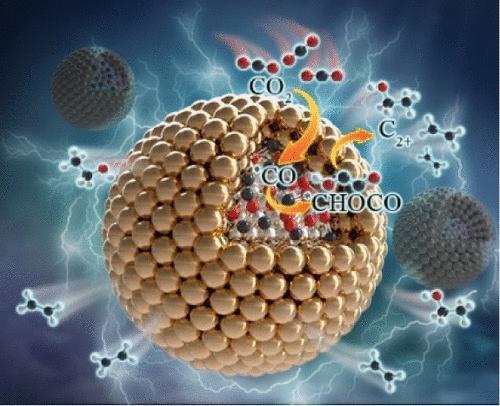在 Ag@Cu2O 级联纳米反应器中对反应中间产物进行封闭催化以促进电化学 C-C 偶联反应
IF 11.3
1区 化学
Q1 CHEMISTRY, PHYSICAL
引用次数: 0
摘要
级联纳米反应器为多组分连续反应和协同转化提供了一个理想的平台。然而,形态调控对封闭催化的影响,尤其是对 CO2RR 中反应中间产物的生成、扩散和二聚化的影响还不甚了解。在此,我们采用两步种子生长法合成了一系列外壳厚度可调的 Ag@Cu2O 级联纳米反应器,观察到 C2+ 产物生成过程中出现了明显的火山型曲线。外壳厚度适中的变体(Ag@Cu2O-40)在-1.6 V(相对于 RHE)电压下的 C2+ 法拉第效率(FE)最高,可达 78.5%。原位拉曼和密度泛函理论(DFT)计算表明,在 Ag 内核上生成的 CO 会溢出并被限制在 Cu2O 外壳上,这对促进 C-C 耦合而不是形成 C1 产物(CO、CH3OH 和 CH4)至关重要。有限元法(FEM)模拟进一步揭示了 Cu2O 壳的最佳厚度能适应 CO2 扩散和 CO 封闭能力,从而最大限度地提高 CO 浓度以形成 C2+ 产物。我们的研究结果体现了合理设计的级联纳米反应器通过约束催化优化反应中间产物的潜力。本文章由计算机程序翻译,如有差异,请以英文原文为准。

Confinement Catalysis of Reaction Intermediates in Ag@Cu2O Cascade Nanoreactors toward Boosted Electrochemical C–C Coupling
Cascade nanoreactors provide an ideal platform for multicomponent sequential reactions and synergistic transformations. However, the effects of morphology modulation on confinement catalysis, particularly regarding the generation, diffusion, and dimerization of reaction intermediates in CO2RR are less discerned. Herein, we synthesized a series of Ag@Cu2O cascade nanoreactors with tunable shell thicknesses by a two-step seeded growth method, observing an obvious volcano-type curve in C2+ products generation. The variant with a medium shell thickness (Ag@Cu2O-40) achieved the highest Faradaic efficiency (FE) of C2+ up to 78.5% at −1.6 V (vs RHE). In situ Raman and density functional theory (DFT) calculations indicate that CO generated on the Ag core spills over and becomes confined at the Cu2O shell, which is crucial in boosting C–C coupling rather than forming C1 products (CO, CH3OH, and CH4). Finite element method (FEM) simulations further reveal that the optimal thickness of the Cu2O shell accommodates CO2 diffusion and CO confinement capabilities, thereby maximizing CO concentration for the formation of C2+ products. Our findings exemplify the potential of rationally designed cascade nanoreactors for optimizing reaction intermediates through confinement catalysis.
求助全文
通过发布文献求助,成功后即可免费获取论文全文。
去求助
来源期刊

ACS Catalysis
CHEMISTRY, PHYSICAL-
CiteScore
20.80
自引率
6.20%
发文量
1253
审稿时长
1.5 months
期刊介绍:
ACS Catalysis is an esteemed journal that publishes original research in the fields of heterogeneous catalysis, molecular catalysis, and biocatalysis. It offers broad coverage across diverse areas such as life sciences, organometallics and synthesis, photochemistry and electrochemistry, drug discovery and synthesis, materials science, environmental protection, polymer discovery and synthesis, and energy and fuels.
The scope of the journal is to showcase innovative work in various aspects of catalysis. This includes new reactions and novel synthetic approaches utilizing known catalysts, the discovery or modification of new catalysts, elucidation of catalytic mechanisms through cutting-edge investigations, practical enhancements of existing processes, as well as conceptual advances in the field. Contributions to ACS Catalysis can encompass both experimental and theoretical research focused on catalytic molecules, macromolecules, and materials that exhibit catalytic turnover.
 求助内容:
求助内容: 应助结果提醒方式:
应助结果提醒方式:


